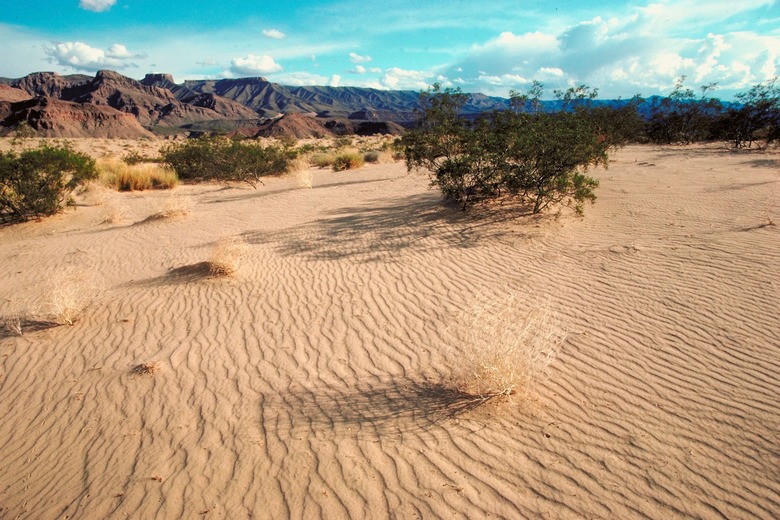Climate Of The Mojave
Situated mainly between the busy metropolitan areas of Los Angeles and Las Vegas, the Mojave Desert spreads across parts of Nevada, Utah, Arizona and one-quarter of the state of California. Perched at elevations of 609 meters (2,000 feet) to 1,524 meters (5,000 feet), the Mojave is known as a high desert, and its climate reflects daily extremes of hot and cold temperatures.
West Mojave Desert Climate
West Mojave Desert Climate
In the western part of the Mojave Desert, winter temperatures are cool, as low as negative 13 degrees Celsius (8 degrees Fahrenheit), while the summers are warm. The marine influence in the western Mojave keeps the summer temperatures from being as extreme as in the central and eastern Mojave. Most of the rainfall in the western Mojave occurs when winter storms come off the Pacific Ocean and move east. And snowfall is a common sight during winter. The western Mojave temperatures and rainfall are sufficient to support an extensive blooming of wildflowers in the spring.
Central Mojave Desert Climate
Central Mojave Desert Climate
In the central Mojave Desert, the winter temperatures are milder than in the eastern or western parts of the desert. To the other extreme, the summers are hotter than in the eastern and western portions of the desert, sometimes reaching about 49 degrees Celsius (120 degrees Fahrenheit) at the lower elevations. Some rain falls in the winter and summer, but the central desert is generally drier than the eastern and western parts of the Mojave. Winds more than 40 kilometers per hour (25 mph) blow regularly, and gusts of 120 kilometers per hour (75 mph) can occur. The winds are present year-round, but they tend to die down in November, December and January.
East Mojave Desert Climate
East Mojave Desert Climate
In the eastern part of the Mojave Desert, winters are cool, with the temperatures dropping below freezing at night. The rainfall in the eastern Mojave is about the same in both winter and summer, and it's a greater rainfall amount than in the central Mojave and most of the west Mojave. Some of this precipitation results from saturated subtropical air that originates over Mexico. This year-round rainfall in east Mojave is adequate to support healthy amounts of desert vegetation.
Precipitation and Mojave Weather
Precipitation and Mojave Weather
On average the Mojave receives less than 12 centimeters (5 inches) of precipitation, falling as rain or snow, a year. There are places on Earth where that measured amount might fall in a single day. Most of the rain the Mojave receives falls between November and April. When rain does fall in the Mojave, it can quickly create a flash flood in a dry stream or lake bed. These heavy rains occur most frequently during the months of July, August, and September, with May and June being the driest months. When the El Nino cycles occur in the Pacific ocean, the warmer air brings more rain to the Mojave.
Cite This Article
MLA
McKinney, Donna. "Climate Of The Mojave" sciencing.com, https://www.sciencing.com/climate-mojave-4033/. 3 August 2018.
APA
McKinney, Donna. (2018, August 3). Climate Of The Mojave. sciencing.com. Retrieved from https://www.sciencing.com/climate-mojave-4033/
Chicago
McKinney, Donna. Climate Of The Mojave last modified March 24, 2022. https://www.sciencing.com/climate-mojave-4033/
